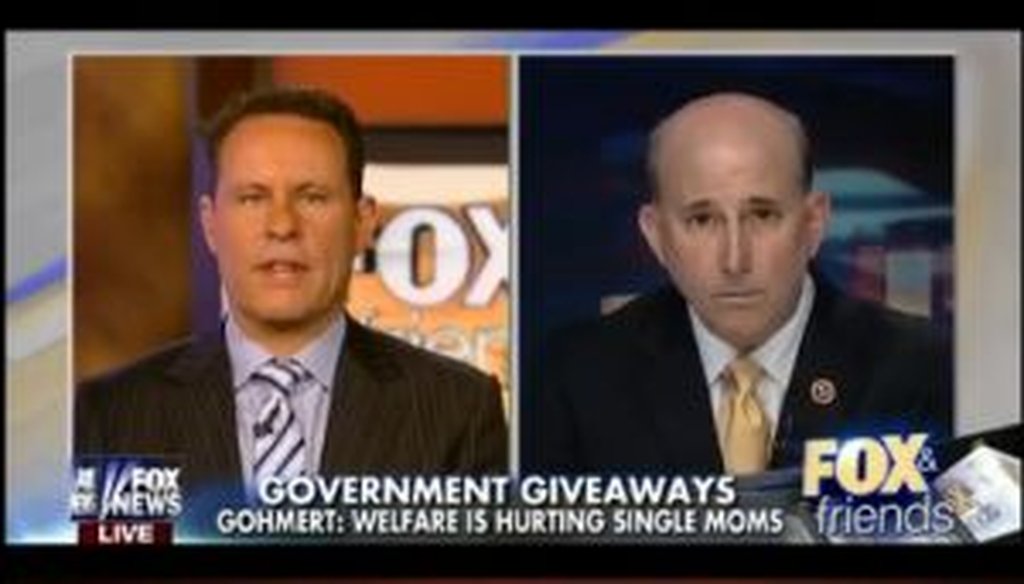

Our only agenda is to publish the truth so you can be an informed participant in democracy.
We need your help.


During an interview on "Fox & Friends," Rep. Louie Gohmert, R-Texas, said that four decades ago, hardly any Americans had health insurance. We looked into his claim.
Rep. Louie Gohmert, R-Texas, went on Fox News recently to explain an unusual decision he’d made: intentionally going without health insurance.
Fox host Brian Kilmeade asked Gohmert about it during an interview on Jan. 23, 2014.
Gohmert told him, "When Obamacare actually kicked in, just as we knew, if you liked your insurance, as I did -- I had a health savings account -- then I wasn't going to be able to keep it because it doesn't meet the requirements." Gohmert continued, "I don't have an extra $1,200 a month. And we are setting money aside in the event we need it. But Brian, don't forget, you know, 40 years ago, hardly anybody in the country had health insurance, and this is one of the areas we really need reform in."
Going without insurance is Gohmert’s decision to make. Presumably, he would be subject to the penalty under Obamacare for not having insurance. That would be $95 per adult or 1 percent of family income, whichever is higher, for 2014, and $325 per adult or 2 percent of family income for 2015, whichever is higher. The penalty goes even higher starting in 2016.
For this fact-check, however, we wondered whether Gohmert was right that "40 years ago, hardly anybody in the country had health insurance."
Gohmert’s office didn’t respond to an inquiry, but right off the bat, we knew there was a problem with this claim. Forty years ago was 1974 -- almost a decade after the creation of Medicare (the universal health care program for Americans age 65 and up) and Medicaid (the health care program for qualifying low-income Americans).
By 1975, Medicare was covering almost 25 million Americans, and Medicaid was covering about 20 million Americans. Even accounting for some overlap between the two programs’ beneficiaries, that’s a lot of Americans who had insurance 40 years ago. The U.S. population at the time was about 214 million, so roughly one of every five or six Americans was covered by these two programs alone.
But maybe Gohmert was talking only about private insurance. So we located data on that, too.
A 2009 paper published by the Centers for Disease Control and Prevention reports that in 1974, nearly 149 million Americans had private insurance, mostly from their employers but in some cases purchased individually. That works out to four out of every five Americans under age 65 with private insurance coverage in 1974 -- a far cry from "hardly anybody."
Gohmert’s claim "might have been closer to being true in the 1930s or ‘40s, but it does not characterize the United States 40 years ago," said Gail Wilensky, who headed Medicare and Medicaid under President George H.W. Bush. (Here’s an earlier story we published about how health coverage operated prior to Medicare and Medicaid. It’s fair to say that health coverage was a whole lot spottier in the early part of the 20th century.)
Michael Tanner, a health-policy specialist at the libertarian Cato Institute, suggested that 40 years ago, insurance may have been more likely to cover big-ticket items such as hospital care and less likely to cover smaller, more routine medical procedures.
Tanner appears to have a point. According to 1974 data published by the Social Security Administration, 75 percent to 80 percent of Americans with private insurance were covered for hospital stays, surgery and X-rays, but only about 60 percent were covered for "office and home visits," and about 70 percent were covered for prescription drugs outside of the hospital setting.
Still, not even these figures help Gohmert’s case, since even the lower percentages for non-hospital care aren’t anywhere near the trivial numbers of insured Americans Gohmert claimed.
Gohmert’s statement is "just flat wrong," Wilensky said.
Our ruling
Gohmert said that "40 years ago, hardly anybody in the country had health insurance." Even ignoring the millions of Americans covered in 1974 by Medicare and Medicaid, 80 percent of Americans under age 65 back then had private insurance coverage, and a solid majority of those plans covered routine doctor visits and prescription drugs in addition to hospital care. These numbers are so far off from Gohmert’s claim that we rate it Pants on Fire.
Louie Gohmert, interview with Fox News, Jan. 23, 2014 (CQ subscribers only)
Social Security Bulletin, "Private Health Insurance in 1974: A Review of Coverage, Enrollment, and Financial Experience," March 1976
Centers for Disease Control and Prevention, "Health Insurance Coverage Trends, 1959–2007: Estimates from the National Health Interview Survey," July 1, 2009
Centers for Medicare and Medicaid Services, "Table 2.1 - Medicare Enrollment: Hospital Insurance and/or Supplementary Medical Insurance Programs for Total, Fee-for-Service and Managed Care Enrollees as of July 1, 2010: Selected Calendar Years 1966-2010"
Centers for Medicare and Medicaid Services, "Medicaid Spending: A Brief History," Fall 2000
Diabetes Care, "Medical Expenditures and Insurance Coverage for People with Diabetes: Estimates from the National Medical Care Expenditure Survey," January-February 1987
U.S. Census Bureau, "Historical National Population Estimates: July 1, 1900 to July 1, 1999"
Kaiser Family Foundation, "The Requirement to Buy Coverage Under the Affordable Care Act," accessed Jan. 24, 2014
Congressional Research Service, "The Market Structure of the Health Insurance Industry," Nov. 17, 2009
NBC News, "Congress: Gohmert goes without health insurance," Jan. 22, 2014
PolitiFact, "Were the early 1960s a golden age for health care?" Jan. 20, 2012
Email interview with Michael Tanner, senior fellow at the Cato Institute, Jan. 23, 2014
Email interview with Gail Wilensky, head of Medicare and Medicaid under President George H.W. Bush, Jan. 23, 2014
In a world of wild talk and fake news, help us stand up for the facts.
